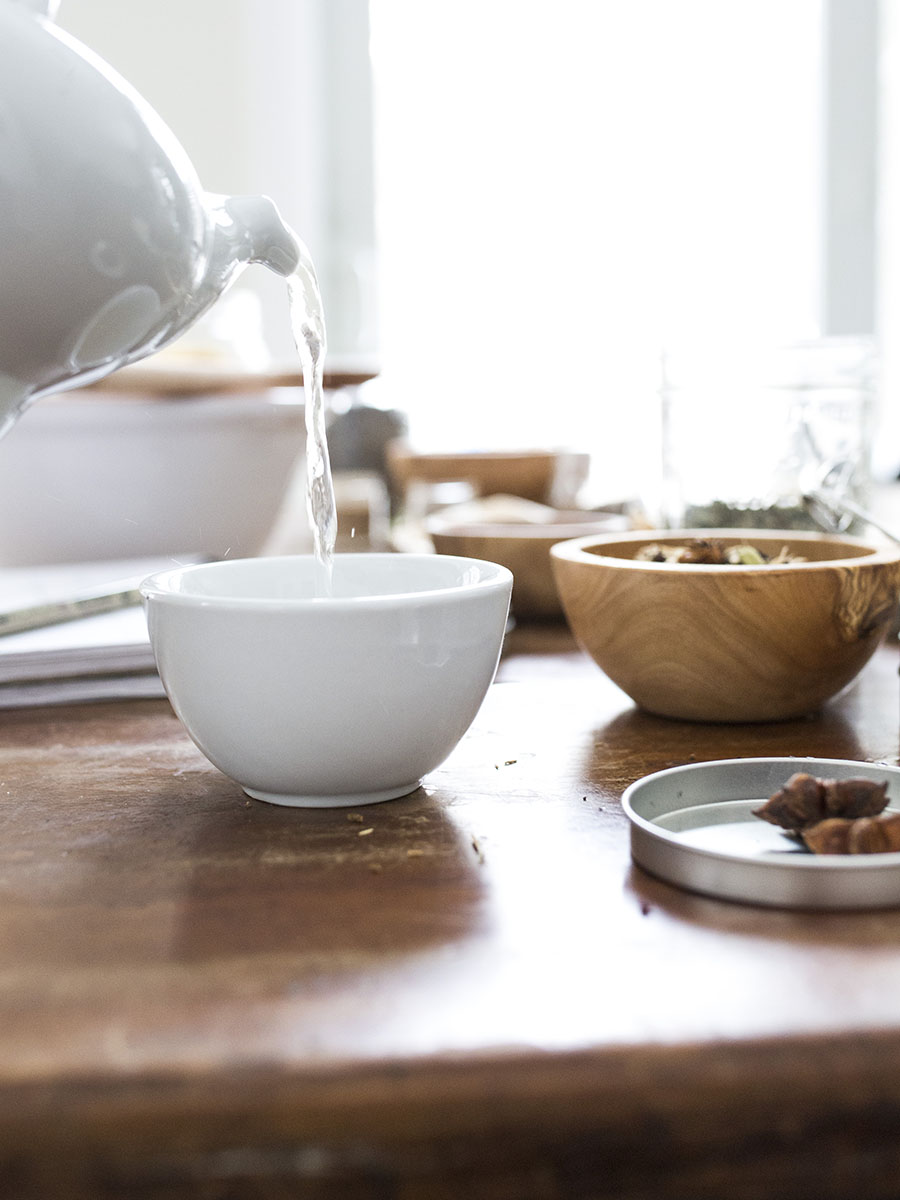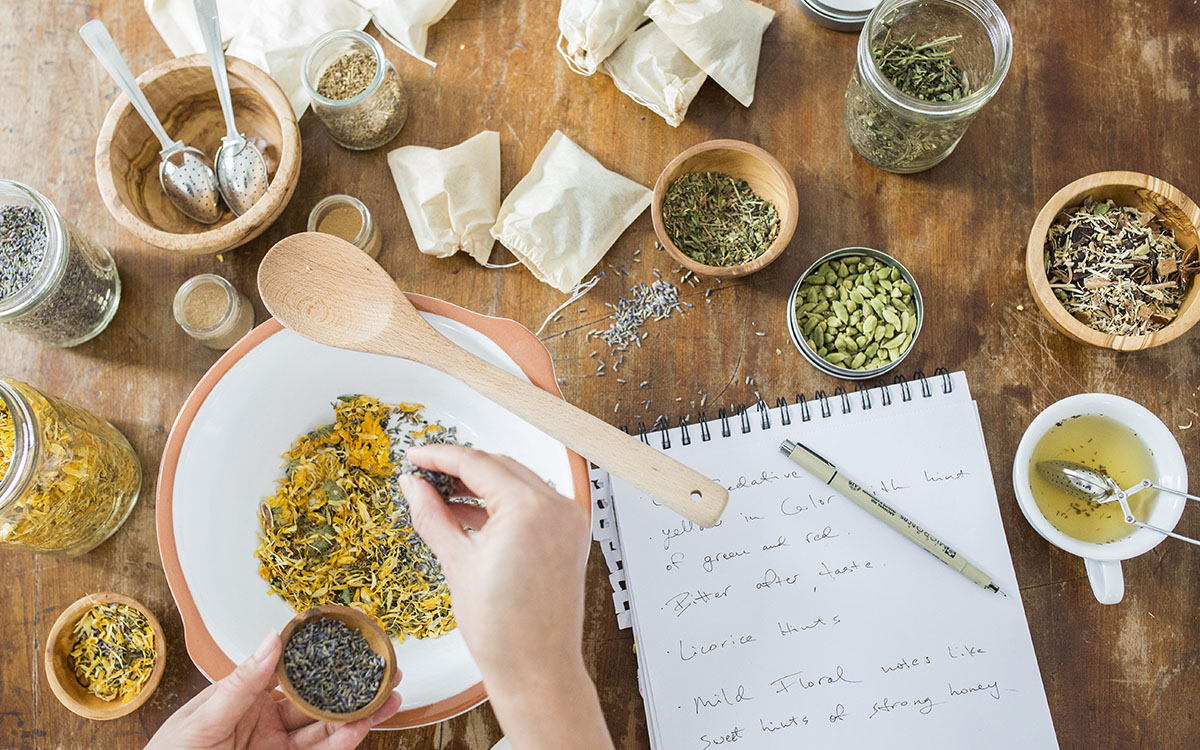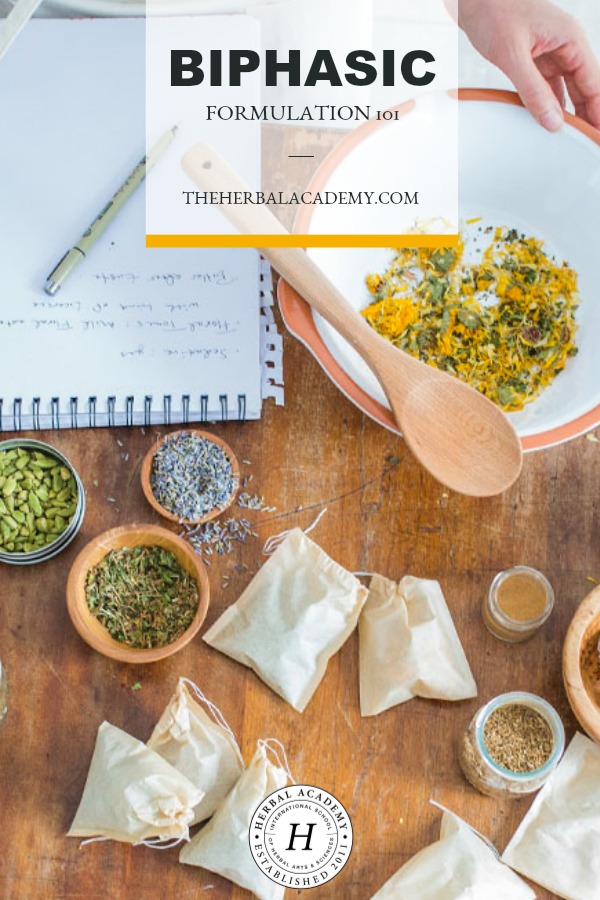
Biphasic Formulation for Menstrual Cycles 101
Many females simply write off their menstrual symptoms as part of who they are as a female. It’s simply “that time of the month” again and there’s “nothing I can do about it.” Although we should recognize and respect the menstrual cycle and the patterns we notice within, there are ways to positively change and affect menstrual symptoms for good. A biphasic formulation is one of them! Read on to discover the essentials of biphasic formulation, why it is important for keeping hormones in balance, and pointers for where to get started when making one.
What is a Biphasic Formula?
A biphasic formula essentially means a formula taken in two phases. While there can be many types of biphasic formulas, the term is typically applied to a formula supporting the two main phases of our menstrual cycle: follicular and luteal. We will be exploring biphasic formulation in relation to the menstrual cycle here, but you can take some of the foundational elements away with you to create other types of biphasic formulas as well.
Follicular Phase
The follicular phase begins at the onset of menstruation and ends at ovulation. This phase typically spans 7-10 days but can vary slightly depending on the person. In this phase, estrogen levels are rising in order to grow uterine lining for carrying the egg at ovulation. Right before ovulation, luteinizing hormone (LH) and follicle-stimulating hormone (FSH) levels rise to prepare the egg follicles for ovulation. These hormones spike the day of ovulation, promoting the release of an egg. Testosterone levels also surge and drop around ovulation time as well (Vitti, 2013).
Luteal Phase
The luteal phase begins at ovulation and ends at the onset of menstruation. This phase typically spans 10-14 days, but like the follicular phase, can also vary depending on the person. Progesterone is the dominant hormone in this phase, beginning to rise right after ovulation. Post-ovulation, estrogen levels dip immediately then begin to rise slightly. If no pregnancy occurs, progesterone production halts and both progesterone and estrogen levels begin to lower, prompting the shedding of the uterine lining (aka, menstruation) to begin. Toward the end of the luteal phase, testosterone levels will also increase (Vitti, 2013).

Sacred Balance
Although this cyclic hormonal rhythm may seem simple and straightforward, the balance is quite intricate. If one of these hormones is slightly off from its normal level, symptoms can occur or the whole menstrual cycle could even be thrown out of whack.
Female bodies are designed to follow this exact hormonal rhythm every menstrual cycle, without intense pain, cramping, mood swings, and bloating. However, if a female does experience any of these, or other, symptoms, they can find gratitude in the fact that their body is trying to tell them something is “off” inside! Females are fortunate that every month they can receive important signals telling them if and how their hormones are out of balance.
Why Take Biphasic Formulas?
It is a common pattern for many herbalists to simply formulate for single menstrual complaints and symptoms individually. For instance, for uterine cramping at the beginning of the menses, they would formulate a tincture to soothe the pain, discomfort, and stagnation at the time it occurs. Or if a female experiences heightened anxiety at different points throughout her cycle, the herbalist might create a formula to be used as needed to calm down as soon as symptoms of anxiousness start to rise.
While these formulas can be very effective in acute situations, they often do not address the root cause of the symptoms. This is where biphasic formulation comes into play. Formulating in respect to the main hormonal phases of the menstrual cycle promotes the hormones’ return to a regular pattern, which in turn, eases symptoms over time.
For those whose menstrual pattern is already pretty regular and symptom-free, taking a biphasic formula can still offer support by tonifying the reproductive organs and promoting the current balance of hormones to stay in the same rhythm. Remember to cross-check other symptoms of imbalance to see if they could be connected with the menstrual cycle. For instance, insomnia, acne, or anxiety could be related to the hormonal picture, too!

Consistency is Key
Consistency is key when taking any herbal formula, but especially with biphasic formulas. In order to regulate or balance the hormonal picture, the body needs regularity with the dosing strategy is as well.
Although the menstrual cycle technically has three phases including the 3-7 day period of menstruation, biphasic formulas are usually taken during the follicular and luteal phases only since progesterone and estrogen levels are pretty low and constant during menstruation. The menstrual phase can be included as part of the follicular phase, since toward the end of menstruation estrogen starts to rise slightly again. However, when taking biphasic formulas with stronger blood-moving and emmenagogue herbs inside, it may be suitable to consider pausing use during the bleeding time (Sheff, 2015; Vitti, 2013).
Typically, biphasic formulas are taken in tincture form at least two times per day. Often times, herbalists will add on supportive formulas if needed as symptoms balance out over time. For instance, if cramps are still debilitating at first, an antispasmodic formula could be used acutely in addition to continuing the biphasic formula. Or if anxiety symptoms flare-up around the time of the menses, a nervine-focused formula could be used as needed.

The Basics of Biphasic Formulation
Since every biphasic formula will be slightly unique based on the symptoms and other contributing factors in the overall health picture, there is no “one-size-fits-all” recipe. However, here are some helpful pointers for creating a biphasic formula.
To begin, start by identifying the primary area of focus you would like support with the formula. For example, this could be fertility issues, intense menstrual cramping, or simply maintaining a healthy balance in the menstrual cycle. If you have more than one focus, list a primary focus and up to three secondary focuses. Observe any additional areas, such as lifestyle practices or nutrition, that could be changed in order to support a shirt toward healthy balance.
Next, list all of the symptoms experienced in relation to the menstrual cycle. These could include but are not limited to (Romm, 2010; Sheff, 2015; Hudson, 2008):
- Uterine cramping
- Ovarian cramping
- Pelvic congestion
- Irritable bowel-type symptoms (bloating, dull abdominal cramping, constipation, loose stools, distension)
- Sleep disorders and insomnia
- Inflammation
- Anxiety
- Depression
- Mood swings
- Breast tenderness
- Blood clots in menstrual blood
- Spotting before or after menses
- Flooding (heavy rush of blood happening all of a sudden during menses)
- Sugar cravings
- Acne
- Irregular menstrual cycle
- Menses longer than 7 days
- Fertility issues
- Lack of menses (amenorrhea)
Then, when designing the formula, think ahead. The herbs taken in one phase prime the body for the next phase. For instance, for a person who always experiences headaches right around menstruation time, incorporate mild-pain soothers, circulatory stimulants, and decongesting herbs in the luteal phase formula to help support the clearance of headache-type symptoms before they occur. The acute headache-balancing and pain-soothing formula can still be use when necessary, but incorporating certain herbs ahead of time will help break things up before they occur (Romm, 2010; Sheff, 2015).
Some actions to focus on during the follicular (estrogen-dominant) phase are (Sheff, 2015):
- Fertility support
- Tonifying the reproductive system
- Incorporating phytoestrogens (plants that can assist in modulating estrogen levels)
- Utilizing blood movers (emmenagogues, which can stabilize dysmenorrhea symptoms felt in the next phase)
- General nervous system building and restoration
In the luteal (progesterone-dominant) phase, consider focusing on:
- Pelvic decongesting
- Supporting healthy progesterone levels
- Mood balancing focused nervous system support
- Utilizing antispasmodics (cramp supportive herbs), pain-soothing herbs, and herbs to support heavy bleeding, if necessary.

Herbs to Incorporate in the Biphasic Formulas
After identifying the areas of focus and general symptom picture and have mapped out an herbal action plan, it’s time to assess the materia media and the herbs that can provide support during the different phases of the cycle (Romm, 2010; Sheff, 2015). The following is a list of herbs divided by action category to be considered for the formulas:
- Pain support (analgesics): black cohosh (Actaea racemosa), Corydalis (Corydalis ambigua), California poppy (Eschscholzia californica), Jamaican dogwood (Piscidia piscipula), valerian (Valeriana officinalis), cramp bark (Viburnum opulus), and black haw (Viburnum prunifolium)
- Cramping support (antispasmodics): yarrow (Achillea millefolium), wild yam (Dioscorea villosa), black cohosh (Actaea racemosa), motherwort (Leonurus cardiaca), white peony (Paeonia lactiflora), cramp bark (Viburnum opulus), black haw (Viburnum prunifolium), and ginger (Zingiber officinale).
- Heavy bleeding support: raspberry leaf (Rubus idaeus), cinnamon (Cinnamomum spp.), lady’s mantle (Alchemilla vulgaris), shepherd’s purse (Capsella bursa-pastoris), and yarrow (Achillea millefolium)
- Phytoestrogens: alfalfa (Medicago sativa), black cohosh (Actaea racemosa), Chinese ginseng (Panax ginseng), licorice (Glycyrrhiza glabra), red clover (Trifolium pratense), wild yam (Dioscorea villosa), and Angelica (Angelica archangelica)
- Reproductive tonics: blue cohosh (Caulophyllum thalictroides), dong quai (Angelica sinensis), motherwort (Leonurus cardiaca), raspberry leaf (Rubus idaeus), Angelica (Angelica archangelica), and partridgeberry (Mitchella repens)
- Progesterone support: flax seed meal (Linum usitatissimum), white peony (Paeonia lactiflora), chaste tree (Vitex agnus-castus), and wild yam (Dioscorea villosa)
- Fertility support: shatavari root (Asparagus racemosus), damiana (Turnera diffusa), raspberry leaf (Rubus idaeus), red clover (Trifolium pratense), nettle (Urtica dioica), Asian ginseng (Panax ginseng), dong quai (Angelica sinensis), ashwagandha (Withania somnifera), black cohosh (Actaea racemosa), and saw palmetto (Serenoa repens)
- Mood + nervous system support: milky oats (Avena sativa), St. John’s wort (Hypericum perforatum), dandelion root (Taraxacum officinale), passionflower (Passiflora incarnata), skullcap (Scutellaria lateriflora), licorice (Glycyrrhiza glabra), and vervain (Verbena officinalis)
Check out the Herbal Academy’s Herbarium for plant-specific details within comprehensive herbal monographs.
Refresh & Check-In
Since the hormonal picture is constantly changing (especially when starting to take steps like these toward changing it!) the same formulation may not be needed long-term. Depending on how the symptom picture shifts, certain herbs included in the formula may no longer be necessary and other herbs can fill in their place.
Whenever formulating, it is important to remember the other important lifestyle and dietary factors impacting the hormonal picture as well. These elements can also play a big role in why certain symptoms continue to linger and the overall balance of the cycle.
Even experienced herbalists will admit that biphasic formulation can sometimes be a tricky process person-by-person. When in doubt, consult a clinical herbalist for insight and assistance on formulating and when considering to use any low-dose herbs. And it’s always important to keep in touch with a primary health care provider for any new, long-term, or deeper concerns.
Interested in learning more about balancing the menstrual cycle and hormones? Check out our post on Seed Cycling For Hormonal Balance or my post on 6 Ways To Balance Your Menstrual Cycle.

REFERENCES
Hudson, T. (2008). Women’s encyclopedia of natural medicine. New York, NY: McGraw-Hill.
Romm, A. (2010). Botanical medicine for women’s health. St. Louis, MS: Churchill Livingstone.
Sheff, E. (2015). Sacred blood: Interpreting the menstrual cycle for health and wellness. Lecture presented at Midwest Women’s Herbal Conference in WI.
Vitti, A. (2013). WomanCode: Perfect your cycle, amplify your fertility, supercharge your sex drive, and become a power source. New York, NY: HarperOne.









